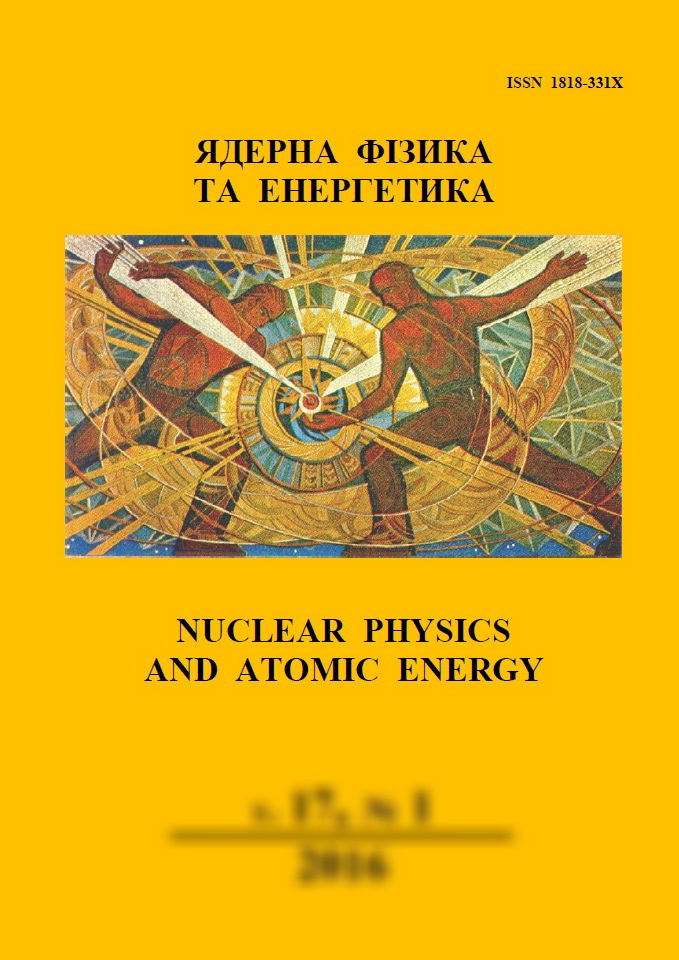 |
Ядерна фізика та енергетика
Nuclear Physics and Atomic Energy
ISSN:
1818-331X (Print), 2074-0565 (Online)
Publisher:
Institute for Nuclear Research of the National Academy of Sciences of Ukraine
Languages:
Ukrainian, English
Periodicity:
4 times per year
Open access peer reviewed journal
|
Nucl. Phys. At. Energy 2005, volume 6, issue 2, pages 106-114.
Section: Radiation Physics.
Received: 02.02.2005; Published online: 30.06.2005.
 Full text (ru)
Full text (ru)
https://doi.org/10.15407/jnpae2005.02.106
The particularities of the formation of radiation defects in silicon with low and high concentration of the oxygen
A. P. Dolgolenko, P. G. Litovchenko, M. D. Varentsov, G. P. Gaidar, A. P. Litovchenko
Institute for Nuclear Research, National Academy of Sciences of Ukraine, Kyiv, Ukraine
Abstract:
It has been studied the radiation hardness of the n-Si samples with low and high concentration of
oxygen (in range from 5 · 1015 to 7 · 1017 сm-3), which were irradiated by fast-pile neutrons of WWR-M
reactor. It has been shown that the fluence of fast-pile neutrons for which the concentration of the electrons
tend to intrinsic value does not depend on the concentrations of oxygen. The dose and temperature
dependences of the effective concentration of carriers have been measured. The theoretical calculation has
been carried out in the framework of Gossik's model, taking into account the recharges of defects not only in
n-Si conducting matrix but also in the space-charge region of defect clusters. The necessity of the additional
overlapping of the space-charge regions resulting from the introduction of point defects has been shown. The
model for explanation of dose dependence for n → p conversion in n-Si samples with low and high
concentrations of the oxygen was proposed. It has been supposed that the space distribution of the
assemblage of di-vacancies and Si di-interstitial atoms is responsible for Fermi level position near the
midgap under high fluencies.
References:
1. Watts S. J., Da Via C., Karpenko A. Macroscopic results for a novel oxygenated silicon material. Nucl. Instrum. and Meth. in Phys. Res. A 485 (2002) 153.
https://doi.org/10.1016/S0168-9002(02)00547-8
2. Lindtstroem G., Contarato D., Fretwurst E. et al. Improved Radiation Tolerance of silicon detectors for HEP applications; results from the CiS-HH project. 2nd RD50 - Workshop on Radiation Hard Semiconductor Devices for Very High Luminosity Colliders (CERN, Geneva, 18-20 May, 2003).
http://www.cern.ch/rd50
3. Dolgolenko A. P. Variation of Carrier Removal Rate with Irradiation Dose in Fast-Pile Neutron Irradiated n-Si. phys. stat. sol. (a) 179 (2000) 179.
https://doi.org/10.1002/1521-396X(200005)179:1%3C179::AID-PSSA179%3E3.0.CO;2-3
4. Mac Evoy B. C., Watts S. J. Defect Engineering Radiation Tolerant Silicon Detectors. Proc. of the 7th Inter. Autumn Meeting, Gettering and Defect Engineering in Semiconductor Technology, GADEST' 97 (Spa, Belgium, Oct. 5-10, 1997) p. 221.
5. Gossick B. R. Disordered Regions in Semiconductors Bombarded by Fast Neutrons. J. Appl. Phys. 30 (1959) 1214.
https://doi.org/10.1063/1.1735295
6. Dolgolenko A. P., Litovchenko P. G., Litovchenko A. P. et al. Influence of growing and doping methods on radiation hardness of n-Si irradiated by fast-pile neutrons. Semiconductor Physics, Quantum Electronics & Optoelectronics 7 (2004) 8.
https://doi.org/10.15407/spqeo7.01.008
7. Dolgolenko A. P., Fishchuk I. I. A-Centres Build-Up Kinetics in the Conductive Matrix of Pulled n-Type Silicon with Calculation of Their Recharges at Defect Clusters. phys. stat. sol. (a) 67 (1981) 407.
https://doi.org/10.1002/pssa.2210670207
8. Huhtinen M. Simulation of non-ionising energy loss and defect formation in silicon. Nucl. Instrum. Meth. A 491 (2002) 194.
https://doi.org/10.1016/S0168-9002(02)01227-5
9. Pellegrino P., Leveque P., Lavita J. et al. Annealing kinetics of vacancy-related defects in low-dose MeV self-ion-implanted n-type silicon. Phys. Rev. B 64 (2001) 195211.
https://doi.org/10.1103/PhysRevB.64.195211
10. Dolgolenko A. P., Fishchuk I. I. Defect Clusters and Simple Defect Build-up Kinetics in Fast-Neutron Irradiated n-Si. phys. stat. sol. (a) 50 (1978) 751.
https://doi.org/10.1002/pssa.2210500248
11. Asghar M., Zafar Iqbai M., Zafar N. Characterization of deep levels introduced by alpha radiation in n-type silicon. J. Appl. Phys. 73 (1993) 3698.
https://doi.org/10.1063/1.352930
12. Долголенко А. П., Литовченко П. Г., Варенцов М. Д., Гайдар Г. П. Энергетическое положение в запрещенной зоне n-Si бистабильного дефекта (CiCs)O в "В" конфигурации. Scientific papers of the institute for Nuclear Research 4 (2003) 63.
https://jnpae.kinr.kyiv.ua/04.1/Articles_PDF/jnpae-2003-04-1-063.pdf
13. Мукашев Б. Н., Колодин Л. Г., Нусупов К. Х. Кинетика отжига радиационных дефектов в кремнии р-типа при температурах 150 ÷ 300 К. Физика и техника полупроводников 12 (1978) 1174.
14. Mac Evoy B., Santocchia A., Hall G. et al. Interdefect Charge Exchange in Silicon Particle Detectors at Cryogenic Temperatures. IEEE Trans. Nucl. Sci. 49 (2002) 1750.
https://doi.org/10.1109/TNS.2002.801668
